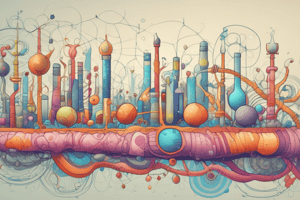Podcast
Questions and Answers
What is the primary function of glycolysis and the citric acid cycle?
What is the primary function of glycolysis and the citric acid cycle?
- To transfer electrons to NAD+ and FAD (correct)
- To break down proteins into amino acids
- To synthesize glucose from pyruvate
- To produce large amounts of ATP
What is the role of NADH and FADH2 in cellular respiration?
What is the role of NADH and FADH2 in cellular respiration?
- To break down glucose into pyruvate
- To produce oxygen as a byproduct
- To synthesize ATP
- To give up electrons to oxidative phosphorylation (correct)
What is the term for the study of energy transformations in living organisms?
What is the term for the study of energy transformations in living organisms?
- Biochemistry
- Biophysics
- Biomechanics
- Bioenergetics (correct)
What type of system is a living cell an example of?
What type of system is a living cell an example of?
What is the term for energy available to do work?
What is the term for energy available to do work?
What is the term for organisms that produce their own food through photosynthesis?
What is the term for organisms that produce their own food through photosynthesis?
What is the term for the process of cellular respiration that occurs in the absence of oxygen?
What is the term for the process of cellular respiration that occurs in the absence of oxygen?
Why is ATP considered a good energy source?
Why is ATP considered a good energy source?
What are the three main kinds of work that a cell performs?
What are the three main kinds of work that a cell performs?
Why does cellular respiration occur in multiple stages?
Why does cellular respiration occur in multiple stages?
Flashcards are hidden until you start studying
Study Notes
Energy Coupling in Cells
- Cells manage energy resources by energy coupling, which uses an exergonic process to drive an endergonic one.
- Most energy coupling in cells is mediated by ATP.
Aerobic Cellular Respiration
- The major stages of aerobic cellular respiration are glycolysis, the citric acid cycle, and oxidative phosphorylation.
- Glucose enters glycolysis, where it is converted into smaller organic molecules, producing a small amount of ATP.
- The final product of glycolysis enters the citric acid cycle, where redox reactions move electrons to the electron carriers NADH and FADH2.
- The electron carriers feed their electrons to molecules in the oxidative phosphorylation process, synthesizing a large amount of ATP.
Glucose Breakdown
- Glucose is broken down into smaller molecules, such as sugars, fats, and amino acids, which are fed into the cellular respiration process.
- Glucose is the most important fuel for cellular respiration, generating a large amount of ATP during its complete breakdown.
ATP and Energy
- ATP is a good energy source because it can be easily converted into energy.
- Example: ATP is used to perform muscle contractions.
- ATP consists of a molecule of adenosine to which three phosphate groups are attached.
- Energy carried by ATP is released when one of the phosphate groups is broken down.
Bioenergetics and Related Terms
- Bioenergetics: the study of energy transformations in living organisms.
- Open system: a system that exchanges energy and matter with its surroundings.
- Free energy: energy available to do work.
- Equilibrium: a state where the rates of forward and reverse reactions are equal.
- Photoautotrophic producer: an organism that produces its own food using sunlight.
- Heterotrophic consumers: organisms that consume other organisms or organic matter for energy.
- Aerobic process: a process that requires oxygen.
- Anaerobic process: a process that does not require oxygen.
Exergonic and Endergonic Reactions
- Exergonic reactions: energy-releasing reactions, where energy is released from the reactants.
- Endergonic reactions: energy-requiring reactions, where energy is absorbed by the reactants.
Cell Work
- The three main kinds of work performed by cells are:
- Mechanical work: muscle contractions.
- Transport work: transporting molecules across cell membranes.
- Chemical work: biosynthesis.
Energy Yield
- One gram of fat yields 9 kcal or 38 kJ, while one gram of carbohydrate yields 4 kcal.
Cellular Respiration
- Cellular respiration takes place in several steps to avoid releasing a large amount of heat at once, which would likely destroy the cell.
- The energy released is controlled, and more energy is captured and converted to ATP, with less energy lost as heat.
Electron Carriers
- The electron carriers involved in the citric acid cycle are NADH and FADH2.
Studying That Suits You
Use AI to generate personalized quizzes and flashcards to suit your learning preferences.




